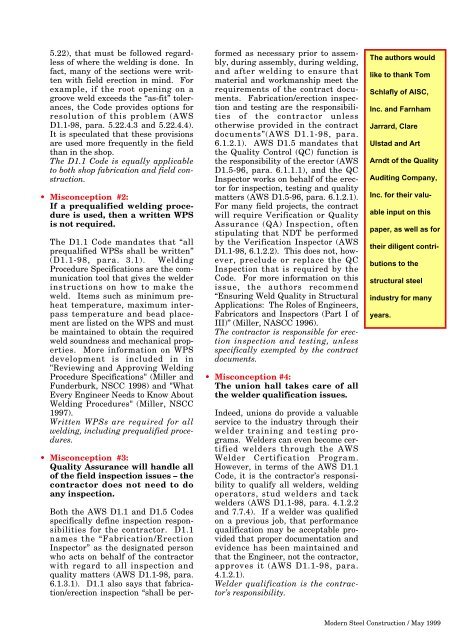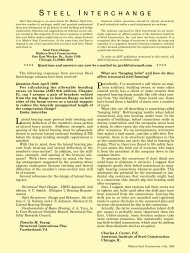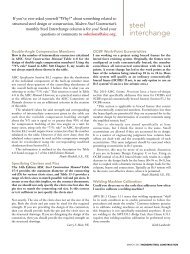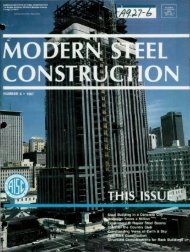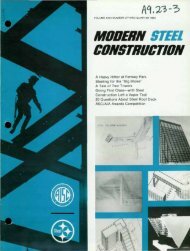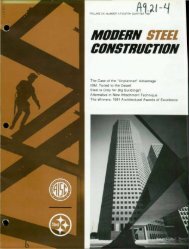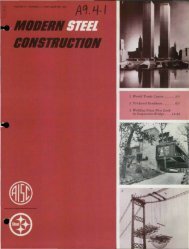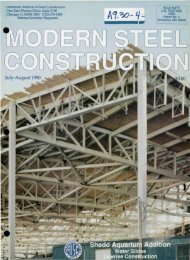what every steel erector should know about welding ... - AISC
what every steel erector should know about welding ... - AISC
what every steel erector should know about welding ... - AISC
You also want an ePaper? Increase the reach of your titles
YUMPU automatically turns print PDFs into web optimized ePapers that Google loves.
5.22), that must be followed regardless<br />
of where the <strong>welding</strong> is done. In<br />
fact, many of the sections were written<br />
with field erection in mind. For<br />
example, if the root opening on a<br />
groove weld exceeds the “as-fit” tolerances,<br />
the Code provides options for<br />
resolution of this problem (AWS<br />
D1.1-98, para. 5.22.4.3 and 5.22.4.4).<br />
It is speculated that these provisions<br />
are used more frequently in the field<br />
than in the shop.<br />
The D1.1 Code is equally applicable<br />
to both shop fabrication and field construction.<br />
Misconception #2:<br />
If a prequalified <strong>welding</strong> procedure<br />
is used, then a written WPS<br />
is not required.<br />
The D1.1 Code mandates that “all<br />
prequalified WPSs shall be written”<br />
(D1.1-98, para. 3.1). Welding<br />
Procedure Specifications are the communication<br />
tool that gives the welder<br />
instructions on how to make the<br />
weld. Items such as minimum preheat<br />
temperature, maximum interpass<br />
temperature and bead placement<br />
are listed on the WPS and must<br />
be maintained to obtain the required<br />
weld soundness and mechanical properties.<br />
More information on WPS<br />
development is included in in<br />
"Reviewing and Approving Welding<br />
Procedure Specifications" (Miller and<br />
Funderburk, NSCC 1998) and "What<br />
Every Engineer Needs to Know About<br />
Welding Procedures" (Miller, NSCC<br />
1997).<br />
Written WPSs are required for all<br />
<strong>welding</strong>, including prequalified procedures.<br />
Misconception #3:<br />
Quality Assurance will handle all<br />
of the field inspection issues – the<br />
contractor does not need to do<br />
any inspection.<br />
Both the AWS D1.1 and D1.5 Codes<br />
specifically define inspection responsibilities<br />
for the contractor. D1.1<br />
names the “Fabrication/Erection<br />
Inspector” as the designated person<br />
who acts on behalf of the contractor<br />
with regard to all inspection and<br />
quality matters (AWS D1.1-98, para.<br />
6.1.3.1). D1.1 also says that fabrication/erection<br />
inspection “shall be per-<br />
formed as necessary prior to assembly,<br />
during assembly, during <strong>welding</strong>,<br />
and after <strong>welding</strong> to ensure that<br />
material and workmanship meet the<br />
requirements of the contract documents.<br />
Fabrication/erection inspection<br />
and testing are the responsibilities<br />
of the contractor unless<br />
otherwise provided in the contract<br />
documents”(AWS D1.1-98, para.<br />
6.1.2.1). AWS D1.5 mandates that<br />
the Quality Control (QC) function is<br />
the responsibility of the <strong>erector</strong> (AWS<br />
D1.5-96, para. 6.1.1.1), and the QC<br />
Inspector works on behalf of the <strong>erector</strong><br />
for inspection, testing and quality<br />
matters (AWS D1.5-96, para. 6.1.2.1).<br />
For many field projects, the contract<br />
will require Verification or Quality<br />
Assurance (QA) Inspection, often<br />
stipulating that NDT be performed<br />
by the Verification Inspector (AWS<br />
D1.1-98, 6.1.2.2). This does not, however,<br />
preclude or replace the QC<br />
Inspection that is required by the<br />
Code. For more information on this<br />
issue, the authors recommend<br />
“Ensuring Weld Quality in Structural<br />
Applications: The Roles of Engineers,<br />
Fabricators and Inspectors (Part I of<br />
III)” (Miller, NASCC 1996).<br />
The contractor is responsible for erection<br />
inspection and testing, unless<br />
specifically exempted by the contract<br />
documents.<br />
Misconception #4:<br />
The union hall takes care of all<br />
the welder qualification issues.<br />
Indeed, unions do provide a valuable<br />
service to the industry through their<br />
welder training and testing programs.<br />
Welders can even become certified<br />
welders through the AWS<br />
Welder Certification Program.<br />
However, in terms of the AWS D1.1<br />
Code, it is the contractor’s responsibility<br />
to qualify all welders, <strong>welding</strong><br />
operators, stud welders and tack<br />
welders (AWS D1.1-98, para. 4.1.2.2<br />
and 7.7.4). If a welder was qualified<br />
on a previous job, that performance<br />
qualification may be acceptable provided<br />
that proper documentation and<br />
evidence has been maintained and<br />
that the Engineer, not the contractor,<br />
approves it (AWS D1.1-98, para.<br />
4.1.2.1).<br />
Welder qualification is the contractor’s<br />
responsibility.<br />
The authors would<br />
like to thank Tom<br />
Schlafly of <strong>AISC</strong>,<br />
Inc. and Farnham<br />
Jarrard, Clare<br />
Ulstad and Art<br />
Arndt of the Quality<br />
Auditing Company,<br />
Inc. for their valu-<br />
able input on this<br />
paper, as well as for<br />
their diligent contri-<br />
butions to the<br />
structural <strong>steel</strong><br />
industry for many<br />
years.<br />
Modern Steel Construction / May 1999


